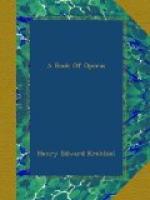There is nothing in “Parsifal,” neither personage nor incident nor thing, no principle of conduct, which did not live in legendary tales and philosophical systems long before Christianity existed as a universal religion. The hero in his first estate was born, bred, went out in search of adventure, rescued the suffering, and righted wrong, just as Krishna, Perseus, Theseus, OEdipus, Romulus, Remus, Siegfried, and Wolf-Dietrich did before him. He is an Aryan legendary and mythical hero-type that has existed for ages. The talismanic cup and spear are equally ancient; they have figured in legend from time immemorial. The incidents of their quest, the agonies wrought by their sight, their mission as inviters of sympathetic interest, and the failure of a hero to achieve a work of succor because of failure to show pity, are all elements in Keltic Quester and Quest stories, which antedate Christianity. Kundry, the loathly damsel and siren, has her prototypes in classic fable and romantic tale. Read the old English ballad of “The Marriage of Sir Gawain.” So has the magic castle of Klingsor, surrounded by its beautiful garden. It is all the things which I enumerated in the chapter devoted to “Tannhauser.” It is also the Underworld, where prevails the law of taboo—“Thou must,” or “Thou shalt not;” whither Psyche went on her errand for Venus and came back scot-free; where Peritheus and Theseus remained grown to a rocky seat till Hercules came to release them with mighty wrench and a loss of their bodily integrity. The sacred lance which shines red with blood after it has by its touch healed the wound of Amfortas is the bleeding spear which was a symbol of righteous vengeance unperformed in the old Bardic day of Britain; it became the lance of Longinus which pierced the side of Christ when Christian symbolism was applied to the ancient Arthurian legends; and you may read in Malory’s “Morte d’Arthur” how a dolorous stroke dealt with it by Balin opened a wound in the side of King Pellam from which he suffered many years, till Galahad healed him in the quest of the Sangreal by touching the wound with the blood which flowed from the spear.
These are the folklore elements in Wagner’s “Parsifal.” It is plain that they might have been wrought into a drama substantially like that which was the poet-composer’s last gift to art without loss of either dignity or beauty. Then his drama would have been like a glorified fairy play, imposing and of gracious loveliness, and there would have been nothing to quarrel about. But Wagner was a philosopher of a sort, and a sincere believer in the idea that the theatre might be made to occupy the same place in the modern world that it did in the classic. It was to replace the Church and teach by direct preachments as well as allegory the philosophical notions which he thought essential to the salvation of humanity. For the chief of these he went to that system of philosophy which rests on the idea that the world is to be redeemed by negation




